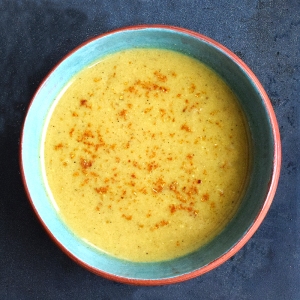
We are of late trying both to reduce the amount of meat we eat during the week and to cut down dramatically on our intake of triglyceride-heavy carbs. Yes, growing old really is a lot of fun. As a result our meals both involve a lot of vegetables and require us to make things that don’t call for rice or chapatis/parathas/tortillas to eat them with. I’ve been making a lot of stews with beans (with and without small amounts of meat) and I’ve also been searing fish and serving it alongside Indian veg dishes in a non-Indian manner (think a piece of fish on a plate with some vegetables alongside). And I’ve been making this cauliflower soup. It uses many of the same spices I’d deploy in a traditional sabzi with gobi. It makes for a very nice meal by itself or with a slice of whole wheat toast. As with my recipe for khatta alu, I garnish it with a pinch of home-made bhaja moshla. If you don’t have any you can sub your favourite garam masala instead. Or you could leave the last bit of masala out completely and just call it roasted cauliflower soup. The main thing is that it is easy and tasty (and perfect in the Minnesota winter). Continue reading
Tag Archives: Soup
Roasted Carrot Soup with Tamarind

The very first vegetable soup I ever made was a carrot soup, the recipe for which I found, of all places, on the Williams-Sonoma website. That bookmarked link no longer goes anywhere but the recipe lives on in my kitchen as a sort-of template for a large number of vegetable soups: carrots cooked with sauteed leeks in stock till softened, pureed and given some brightness with acid. The recipe I have for you today differs in some important ways—there are no potatoes in this, the acid comes from tamarind, and I add toasted spices and finally the nutty zing of a mustard seed-curry leaf tadka. But the structure is still the same. My thanks to whoever it was that put that recipe up on the Williams-Sonoma site back in the day. Continue reading
Asparagus Soup with Coconut Milk and Lime

The other day I had the rare opportunity to take an undisturbed afternoon nap. As would naturally happen to anyone, when just on the verge of falling asleep my mind summoned forth the image of the bag of aspargus I had in the fridge. I’d used some of it for last week’s panch mishali torkari but there was still a lot of it left. Asparagus, as you know, is not a restful vegetable and the next thing I knew I had an idea for asparagus soup racing through my head. I leapt out of bed and went into the kitchen and made it. And it was good. Being kind, I am willing to share the recipe with you. Things to note are there two. First, despite asparagus being the main ingredient, this is not very asparagusy—you can address this if you so desire by simply using more asparagus. Second, the flavours here are not at all Indian, more Southeast Asian. Okay, lets make soup. Continue reading
Squash “Bisque”

I made this squash “bisque” with Indian spices for a dinner party recently and it turned out quite well. I put bisque in quotes because traditionally a bisque has shellfish or shellfish stock in it and this doesn’t. I was planning to deploy dried shrimp for that purpose but it turned out we were out. The Korean corner of the pantry, however, had some dried anchovies and so I used that instead. It came out very well. The picture here has mussels in it because when I heated up the leftovers a few days later, I brought it to a boil and threw in a pound of mussels. That made it even better. But it’s pretty good without the mussels (and would be very good with shrimp too) and, indeed, the recipe can be very easily adapted to make it vegetarian or even vegan (see below). Continue reading
Roasted Squash Soup with Ginger and Cumin (Indian Home Cooking Week 2)

For the first two entries of this edition of Indian Home Cooking Week I’ve posted two fairly traditional parts of a Bengali meal. This third entry is neither traditional nor Bengali. It is my take on non-Indian roasted squash soups with Indian flavours and techniques. It is very easy to make and I think you will like it a lot—it’s a great winter soup. You can serve it as part of a multi-course meal (Indian or otherwise) or just have a big bowl of it as a standalone meal. It could even probably work as a sauce for fish along with rice. The possibilities are endless. By which I mean that there are at least three possibilities.
